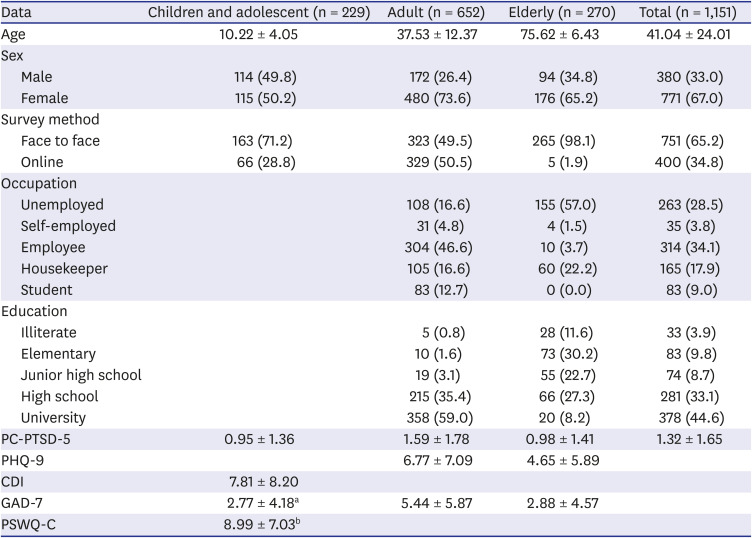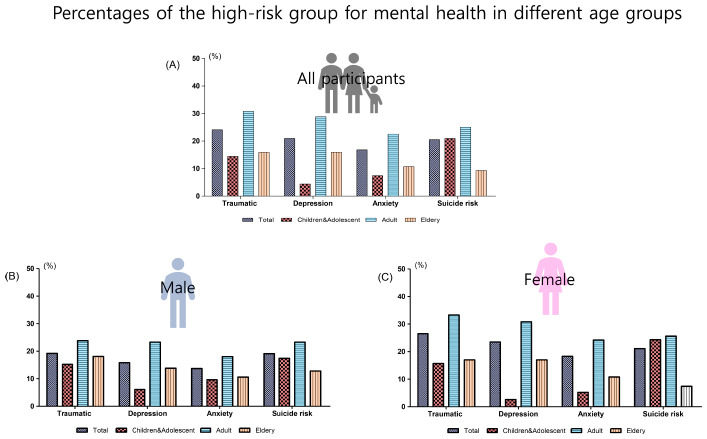1. American Psychological Association. Diagnostic and Statistical Manual of Mental Disorders (DSM-5®). 5th ed. Washington, D.C., USA: American Psychiatric Association;2013.
2. Bridgland VM, Moeck EK, Green DM, Swain TL, Nayda DM, Matson LA, et al. Why the COVID-19 pandemic is a traumatic stressor. PLoS One. 2021; 16(1):e0240146. PMID:
33428630.

3. González-Sanguino C, Ausín B, Castellanos MÁ, Saiz J, López-Gómez A, Ugidos C, et al. Mental health consequences during the initial stage of the 2020 coronavirus pandemic (COVID-19) in Spain. Brain Behav Immun. 2020; 87:172–176. PMID:
32405150.

4. Salari N, Hosseinian-Far A, Jalali R, Vaisi-Raygani A, Rasoulpoor S, Mohammadi M, et al. Prevalence of stress, anxiety, depression among the general population during the COVID-19 pandemic: a systematic review and meta-analysis. Global Health. 2020; 16(1):57. PMID:
32631403.

5. Hong J, Lee D, Ham B, Lee S, Sung S, Yoon T. The Survey of Mental Disorders in Korea. Sejong, Korea: Ministry of Health & Welfare;2017.
6. O'Driscoll M, Ribeiro Dos Santos G, Wang L, Cummings DAT, Azman AS, Paireau J, et al. Age-specific mortality and immunity patterns of SARS-CoV-2. Nature. 2021; 590(7844):140–145. PMID:
33137809.
7. Chopik WJ. Death across the lifespan: age differences in death-related thoughts and anxiety. Death Stud. 2017; 41(2):69–77. PMID:
27573253.

8. Jung YE, Kim D, Kim WH, Roh D, Chae JH, Park JE. A brief screening tool for PTSD: validation of the Korean version of the primary care PTSD screen for DSM-5 (K-PC-PTSD-5). J Korean Med Sci. 2018; 33(52):e338. PMID:
30584416.

9. Park SJ, Choi HR, Choi JH, Kim K, Hong JP. Reliability and validity of the Korean version of the Patient Health Questionnaire-9 (PHQ-9). Anxiety Mood. 2010; 6(2):119–124.
10. Cho SC, Lee YS. Development of the Korean form of the Kovacs' Children's Depression Inventory. J Korean Neuropsychiatr Assoc. 1990; 29(4):943–956.
11. Seo JG, Park SP. Validation of the Generalized Anxiety Disorder-7 (GAD-7) and GAD-2 in patients with migraine. J Headache Pain. 2015; 16(1):97. PMID:
26596588.

12. Kang SG, Shin JH, Song SW. Reliability and validity of the Korean version of the Penn State Worry Questionnaire in primary school children. J Korean Med Sci. 2010; 25(8):1210–1216. PMID:
20676335.

13. Dube P, Kurt K, Bair MJ, Theobald D, Williams LS. The p4 screener: evaluation of a brief measure for assessing potential suicide risk in 2 randomized effectiveness trials of primary care and oncology patients. Prim Care Companion J Clin Psychiatry. 2010; 12(6):e1–e8.
14. Prins A, Bovin MJ, Smolenski DJ, Marx BP, Kimerling R, Jenkins-Guarnieri MA, et al. The primary care PTSD screen for DSM-5 (PC-PTSD-5): development and evaluation within a veteran primary care sample. J Gen Intern Med. 2016; 31(10):1206–1211. PMID:
27170304.

15. Bovin MJ, Kimerling R, Weathers FW, Prins A, Marx BP, Post EP, et al. Diagnostic accuracy and acceptability of the Primary Care Posttraumatic Stress Disorder Screen for the Diagnostic and Statistical Manual of Mental Disorders (Fifth Edition) among US veterans. JAMA Netw Open. 2021; 4(2):e2036733. PMID:
33538826.

16. Kroenke K, Spitzer RL, Williams JB. The PHQ-9: validity of a brief depression severity measure. J Gen Intern Med. 2001; 16(9):606–613. PMID:
11556941.
17. Manea L, Gilbody S, McMillan D. Optimal cut-off score for diagnosing depression with the Patient Health Questionnaire (PHQ-9): a meta-analysis. CMAJ. 2012; 184(3):E191–E196. PMID:
22184363.

18. Kovacs M. The Children's Depression, Inventory (CDI). Psychopharmacol Bull. 1985; 21(4):995–998. PMID:
4089116.
19. Bang YR, Park JH, Kim SH. Cut-off scores of the children's depression inventory for screening and rating severity in Korean adolescents. Psychiatry Investig. 2015; 12(1):23–28.

20. Spitzer RL, Kroenke K, Williams JB, Löwe B. A brief measure for assessing generalized anxiety disorder: the GAD-7. Arch Intern Med. 2006; 166(10):1092–1097. PMID:
16717171.
21. Chorpita BF, Tracey SA, Brown TA, Collica TJ, Barlow DH. Assessment of worry in children and adolescents: an adaptation of the Penn State Worry Questionnaire. Behav Res Ther. 1997; 35(6):569–581. PMID:
9159982.

22. Jiao WY, Wang LN, Liu J, Fang SF, Jiao FY, Pettoello-Mantovani M, et al. Behavioral and emotional disorders in children during the COVID-19 epidemic. J Pediatr. 2020; 221:264–266.e1. PMID:
32248989.

23. Oosterhoff B, Palmer CA, Wilson J, Shook N. Adolescents' motivations to engage in social distancing during the COVID-19 pandemic: associations with mental and social health. J Adolesc Health. 2020; 67(2):179–185. PMID:
32487491.

24. Xie X, Xue Q, Zhou Y, Zhu K, Liu Q, Zhang J, et al. Mental health status among children in home confinement during the coronavirus disease 2019 outbreak in Hubei Province, China. JAMA Pediatr. 2020; 174(9):898–900. PMID:
32329784.

25. Ghandour RM, Sherman LJ, Vladutiu CJ, Ali MM, Lynch SE, Bitsko RH, et al. Prevalence and treatment of depression, anxiety, and conduct problems in US children. J Pediatr. 2019; 206:256–267.e3. PMID:
30322701.

26. Masten AS. Ordinary magic. Resilience processes in development. Am Psychol. 2001; 56(3):227–238. PMID:
11315249.

27. Dvorsky MR, Breaux R, Becker SP. Finding ordinary magic in extraordinary times: child and adolescent resilience during the COVID-19 pandemic. Eur Child Adolesc Psychiatry. 2021; 30:1829–1831. PMID:
32613259.

28. Schmidt SJ, Barblan LP, Lory I, Landolt MA. Age-related effects of the COVID-19 pandemic on mental health of children and adolescents. Eur J Psychotraumatol. 2021; 12(1):1901407. PMID:
33968328.

29. Jung JS, Park SJ, Kim EY, Na KS, Kim YJ, Kim KG. Prediction models for high risk of suicide in Korean adolescents using machine learning techniques. PLoS One. 2019; 14(6):e0217639. PMID:
31170212.

30. Ministry of Education, Ministry of Health and Welfare, Korea Centers for Disease Control and Prevention. The 14th (2018) Korea Youth Risk Behavior Web-based Survey Statistics. Seoul, Korea: Ministry of Education, Ministry of Health and Welfare;2018.
31. American Psychological Association. Stress in America 2020: a National Mental Health Crisis. Washington, D.C., USA: American Psychiatric Association;2020.
32. Birditt KS, Turkelson A, Fingerman KL, Polenick CA, Oya A. Age differences in stress, life changes, and social ties during the COVID-19 pandemic: Implications for psychological well-being. Gerontologist. 2021; 61(2):205–216. PMID:
33346806.

33. Bruine de Bruin W. Age differences in COVID-19 risk perceptions and mental health: evidence from a national US survey conducted in March 2020. J Gerontol B Psychol Sci Soc Sci. 2021; 76(2):e24–e29. PMID:
32470120.

34. Carstensen LL. Integrating cognitive and emotion paradigms to address the paradox of aging. Cogn Emotion. 2019; 33(1):119–125.

35. Scott SB, Poulin MJ, Silver RC. A lifespan perspective on terrorism: age differences in trajectories of response to 9/11. Dev Psychol. 2013; 49(5):986–998. PMID:
22709132.

36. Neubauer AB, Smyth JM, Sliwinski MJ. Age differences in proactive coping with minor hassles in daily life. J Gerontol B Psychol Sci Soc Sci. 2019; 74(1):7–16. PMID:
29931247.

37. Carstensen LL. Evidence for a life-span theory of socioemotional selectivity. Curr Dir Psychol Sci. 1995; 4(5):151–156.

38. Li F, Luo S, Mu W, Li Y, Ye L, Zheng X, et al. Effects of sources of social support and resilience on the mental health of different age groups during the COVID-19 pandemic. BMC Psychiatry. 2021; 21(1):16. PMID:
33413238.

39. Qiu J, Shen B, Zhao M, Wang Z, Xie B, Xu Y. A nationwide survey of psychological distress among Chinese people in the COVID-19 epidemic: implications and policy recommendations. Gen Psychiatr. 2020; 33(2):e100213. PMID:
32215365.

40. World Health Organization. Mental Health and Psychosocial Considerations during the COVID-19 Outbreak. Geneva, Switzerland: World Health Organization;2020.
41. Fox S, Schwartz D. Social desirability and controllability in computerized and paper-and-pencil personality questionnaires. Comput Human Behav. 2002; 18(4):389–410.

42. Cha CB, Franz PJ, M Guzmán E, Glenn CR, Kleiman EM, Nock MK. Annual Research Review: suicide among youth - epidemiology, (potential) etiology, and treatment. J Child Psychol Psychiatry. 2018; 59(4):460–482. PMID:
29090457.

43. Kessler RC, Borges G, Walters EE. Prevalence of and risk factors for lifetime suicide attempts in the National Comorbidity Survey. Arch Gen Psychiatry. 1999; 56(7):617–626. PMID:
10401507.









 PDF
PDF Citation
Citation Print
Print




 XML Download
XML Download